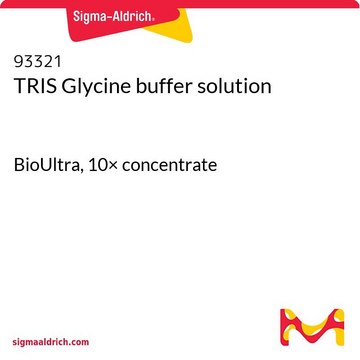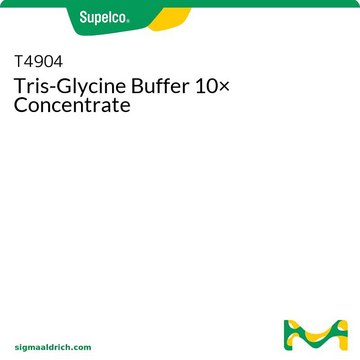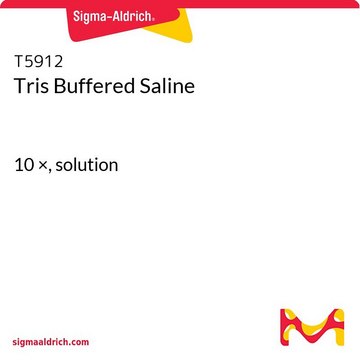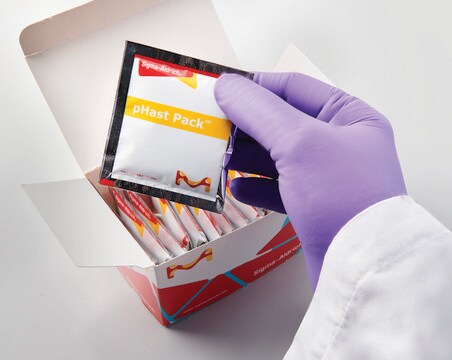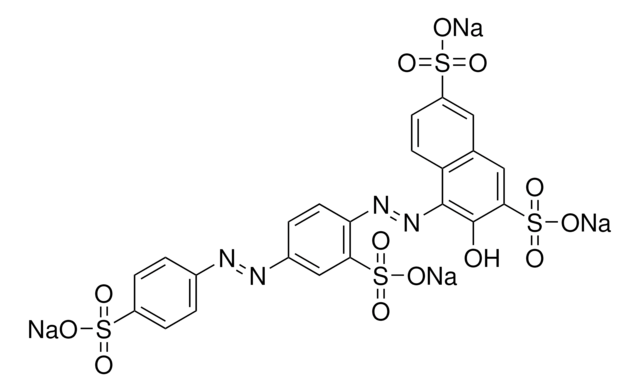T7777
Tris-Glycine-SDS Buffer 10× Concentrate
Synonym(s):
TRIS glycine SDS buffer solution
Sign Into View Organizational & Contract Pricing
All Photos(1)
About This Item
UNSPSC Code:
41105319
eCl@ss:
32129211
NACRES:
NA.25
Recommended Products
sterility
0.2 μm filtered
form
liquid
application(s)
diagnostic assay manufacturing
storage temp.
2-8°C
Looking for similar products? Visit Product Comparison Guide
General description
Tris-glycine-SDS (TGS) running buffer is the most commonly used buffer for sodium dodecyl sulfate-polyacrylamide gel electrophoresis (SDS-PAGE) of proteins. TGS is usually used for both anode and cathode buffer. Recommended running conditions is 150 volts for mini vertical gel electrophoresis units.
Application
Tris-glycine-SDS buffer 10× concentrate has been used as a running buffer in sodium dodecyl sulfate-polyacryamide gel electrophoresis (SDS-PAGE). It is also used to block membranes with 5% non-fat dry milk for western blotting. TGS is usually used for both the anode buffer and the cathode buffer. Recommended running conditions is 150 volts for mini vertical gel electrophoresis units.
Reconstitution
Dilution of the 10× TGS buffer produces a 1× running buffer containing 25 mM Tris, 192 mM glycine and 0.1% SDS, pH approx. 8.6.
Storage Class Code
10 - Combustible liquids
WGK
WGK 1
Flash Point(F)
Not applicable
Flash Point(C)
Not applicable
Personal Protective Equipment
dust mask type N95 (US), Eyeshields, Gloves
Certificates of Analysis (COA)
Search for Certificates of Analysis (COA) by entering the products Lot/Batch Number. Lot and Batch Numbers can be found on a product’s label following the words ‘Lot’ or ‘Batch’.
Already Own This Product?
Find documentation for the products that you have recently purchased in the Document Library.
Antitumor Activity and Mechanism of a Reverse Transcriptase Inhibitor, Dapivirine, in Glioblastoma
Liu W, et al.
Journal of Cancer, 117?128-117?128 (2018)
Multiple tandem epitope tagging for enhanced detection of protein expressed in mammalian cells
Zhang L, et al.
Molecular Biotechnology, 19(3), 313-321 (2001)
A Radioisotope-free Oligosaccharyltransferase Assay Method
Yamasaki T and Kohda D
Glycobiology (2007)
Man-Lan Guo et al.
Cell biochemistry and function, 37(2), 72-83 (2019-02-19)
Cancer cell progression and proliferation increase cell density, resulting in changes to the tumour site, including the microenvironment. What is not known is if increased cell density influences the aggressiveness of cancer cells, especially their proliferation, migration, and invasion capabilities.
Weiwen Liu et al.
The Journal of dermatology, 48(3), 289-300 (2020-12-02)
Androgenetic alopecia is the most common form of hair loss disorder. The features of this process are shortening of the anagen phase in hair cycling and progressive miniaturization of the hair follicle. However, the mechanisms in androgenetic alopecia are still
Our team of scientists has experience in all areas of research including Life Science, Material Science, Chemical Synthesis, Chromatography, Analytical and many others.
Contact Technical Service